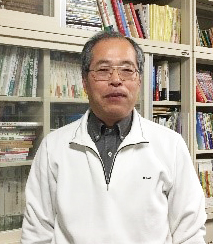Katsuhiro SAITO, Professor
・Cross-Appointed Faculty, International Program in Agricultural Development Studies (IPADS)
Laboratory of Development Economics, Department of Agricultural and Resource Economics,
Graduate School of Agricultural and Life Sciences, the University of Tokyo
http://park.itc.u-tokyo.ac.jp/agriecon/index.html
Contact information:
Phone +813-5841-5319
>EMAIL katsuhirosaito[at]g.ecc.u-tokyo.ac.jp
Professional Experience & Education
| 2020-Present: | Professor, Graduate School of Agricultural and Life Sciences, University of Tokyo |
|---|---|
| 1997-2020: | Associate Professor, Graduate School of Agricultural and Life Sciences, University of Tokyo |
| (2003-2004): | Visiting Researcher, Department of Economics, University of Colorado at Bourlder, USA |
| 1997: | Associate Professor, Graduate School of Agricultural and Life Sciences, The University of Tokyo |
| 1994: | Visiting Researcher, Food and Agricultural Policy Research Institute (FAPRI) at University of Missouri at Columbia, USA |
| 1994: | Ph.D, Faculty of Agriculture, University of Tokyo |
| 1990: | Assistant Professor, Department of Horticultural Economics, faculty of Horticulture, Chiba University |
Discipline(s)
Agricultural and Resource Economics, Development Economics, Quantitative Economic Analysis, Computable General Equilibrium Analysis
Research interests
My research interest is to improve economic welfare of people around the world through policy analysis. For this purpose, many quantitative methods such as econometrics, input output model and computable general equilibrium model has been applied. In addition, I have strong interest on international trade theory.
Geographically, I have focused on Asian countries such as Laos, Cambodia, Nepal and Sri Lanka as well as Japan.
Study example
- Effects of Climate Change on Agricultural Income and Poverty: We are studying the impacts of climate change on agricultural production and income with computable general equilibrium model in Sri Lanka. In this study, the effect of climate change on poverty is also considered with micro simulation module.
- Volatility of International price of rice and poverty. We are studying the relation between volatility of international price of rice and poverty. Especially correlation of yield variation among rice producing countries are carefully examined since it induce “systemic risk” of higher volatility of international price. Monte Carlo simulation was employed with rice trade model.
- Impact evaluation of micro finance. Micro finance has two objectives: one is microeconomic objective such as improving household welfare (income) and macroeconomic objective for national economic growth. We evaluate both effects in this study. We employ project evaluation method for testing the increase in rural household income due to microfinance in VietNum, then evaluate macroeconomic effect based on modified input output analysis with income linkage.
- The effects of African Swine Fever outbreak in China. China, who has a very big share of swine raising, about 50%, experienced the outbreak of ASF. We examine the effect of ASF outbreak in China on international price with employing partial equilibrium international trade model. In addition, we also evaluated an impact of ASF spread into Japan by using interregional input output model.
- Quantitative agricultural policy evaluation. We evaluated, for example, Japanese domestic dairy policy with partial equilibrium model, and also evaluate the effect of trade liberalization such as TPP with computable general equilibrium model.
■Major publications
Pham Tien Thanh, Katsuhiro Saito, and Pham Bao Duong, Impact of microcredit on rural household welfare and economic growth in Vietnam, Journal of Policy Modeling,41(1), 120-139, 2019.
SATO Hideyasu and Katsuhiro SAITO, Economic Analysis of Demand for Dairy Products in Japan: An Estimation of “Micro” and “Macro” Elasticities of Substitution, Journal or Rural Economics 91(1), 71-76, 2019.
SAITO Konomi, Katsuhiro SAITO and Takeshi HAGA, African Swine Fever Outbreak in China and International Price of Swine Meat, Soka Economic Review 48, 85-96, 2019.
SAITO Konomi, Katsuhiro SAITO and Hideyasu SATO, Rice Yield Variation and International Price of Rice, Soka Economic Review 47, 39-53, 2018.
Chatura Wijetunga and Katsuhiro Saito, Evaluating the Fertilizer Subsidy Reforms in the Rice Production Sector in Sri Lanka: A Simulation Analysis, Advances in Management and Applied Economics 7(1), 31-51, 2017.
SAITO Katsuhiro, Hideyasu SATO and Takeshi HAGA, Impact of mastitis on the domestic supply of raw milk and butter in Japan, Journal of Food System Research 23(3), 223-228, 2016.
Damaru Ballabha Paudel and Katsuhiro Saito, Impact of Implementation of Current Land Reform Policy in Nepal, Japanese Journal of Rural Economics 17, 35-39, 2015.
Damaru Ballabha Paudel and Katsuhiro Saito, Technical Inefficiency Effects among National Cereal Grain Balance Producers and Need for Implementation of Land Reform in Nepal, Japanese Journal of Rural Economics 16, 66-72, 2014.
SHIMADA Taiki and Katsuhiro SAITO, On Mesuring Japan’s Agricultural Export Potential: With a Generalized Gravity Model, Journal of Rural Economics Special Issues 2014, 218-222, 2014.
KISHI Kouhei and Katsuhiro SAITO, The Rice Production Risk and Farmer’s Risk Attitude in Tohoku and Hokuriku, Journal of Rural Economics 87(2), 145-149, 2015.
SAITO Katsuhiro, International Specialization of Firm Activities and Global Value Chain, Journal of Food System Research 22(2), 139-143, 2015.
OKONOGI Satoru and Katsuhiro SAITO, The Consequences of Health Shocks and the Vulnerability of the Poor: Evidence from VietNam Household Living Standard Surveys, Journal of Rural Community Studies 121, 28-41, 2015
SAITO Katsuhiro, Estimation of Social Accounting Matrix of Lao and the Possibility of Resource Based Economic Development, Input Output Analysis: Business Journal of PAPAIOS 20(1), 59-71, 2012.
KOBAYASHI Shintaro, Katsuhiro SAITO, Hajime Tanji, Huang Wefeng and Minoru TADA, “Economic Structure of Cambodia and Strategies for Pro-Poor Growth: Results from a Computable General Equilibrium Analysis”, Regional Studies 38(1), 137-154, 2008.
